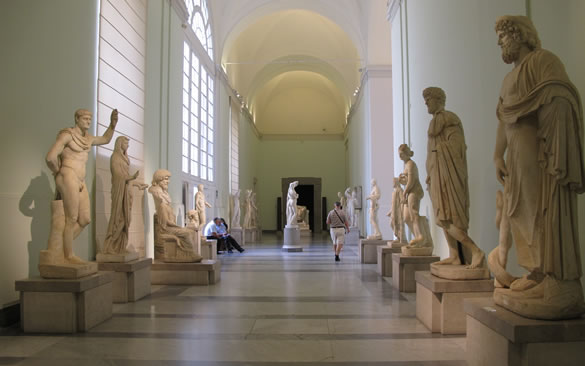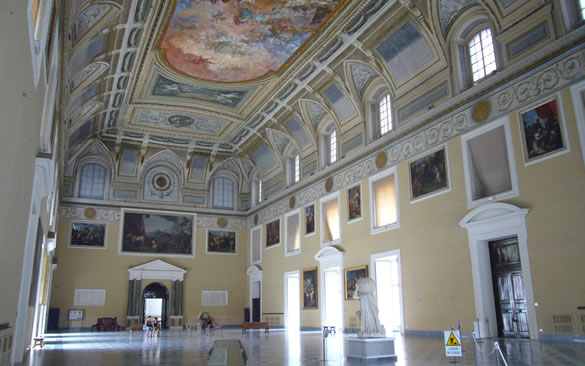
The building which houses the museum was built in the 16th century as a military barracks, later becoming the seat of the Royal Studies. A series of exceptional events helped transform it into the Bourbon Museum, such as the acquisition of the Farnese collection, inherited by Charles of Bourbon from his mother Elisabetta Farnese, and the exhibition of archaeological finds from Herculaneum, Pompeii and Stabia.
The Farnese Collection contains many splendid sculptures from the Baths of Caracalla in Rome, such as the Toro Farnese, the largest existing sculpture since ancient times, and the magnificent statue of Hercules. Visiting the collection of gems you will be attracted by the Farnese Cup, dating back to 150 BC. and considered one of the biggest cameos in the world.
Many of the mosaics displayed in the museum come from the House of the Faun in Pompeii. The most famous one depicts the battle of Isso, consisting of more than 1,500,000 very small marble tesserae.
The Secret Cabinet is an impressive and entertaining collection of scenes and erotic objects from Pompeii and Herculaneum.
The frescoes are splendid examples of the evolution of Pompeian painting between the first century BC and the first century AD. They allow us to get an idea of daily life in the Roman cities of two thousand years ago.
Finally, the Villa dei Papiri in Ercolano shows us some original Roman papyri and statues, the Temple of Isis of Pompeii is rich in testimonies of a religious cult imported from Egypt and the glass collection is made particularly famous by its famous masterpiece, the blue vase.
The Charterhouse of San Martino It was built in 1325 on a tuff hill overlooking the whole town. The original Gothic decorations were almost completely covered by superstructures due to renovation work which began in the 16th century and concluded in 18th century. This made the Charterhouse a magnificent example of Neapolitan baroque.
The interior of the church is a splendid Neapolitan anthology. Most of the frescoes are by Giovanni Lanfranco and Battistello Caracciolo. The paintings on the walls of the choir are by Ribera, Massimo Stanzione and Guido Reni. The vault of the Cappella del Tesoro was decorated by Luca Giordano and depicts the Triumph of Giuditta.
Around the large cloister there are the ancient monastic cells which, attentively restored, house a section of particularly interesting paintings on Naples and its history, including the famous Tavola Strozzi, the first view of Naples dating back to the 15th century.
The section of Christmas cribs containing the Cuciniello Crib, one of the best cribs of the 19th century is very interesting. Also, not to be missed, is the Abbot's apartment, located in a very panoramic position.
Only a few years ago, even the Pharmacy was reopened to the public again, as was the naval section, containing splendid examples of original Bourbon boats.
Charles of Bourbon ordered the construction of a new royal palace on the hill of Capodimonte,as that area was particularly suitable for hunting.
The work, which began in September 1738, ended more than a hundred years later. A wing of the palace was later transformed into a museum to display the paintings of the Farnese collection, inherited from Carlo's mother, Elisabetta Farnese.
During the second half of the nineteenth century, the Farnese and Bourbon armouries became part of the palace's collections, together with the porcelain parlour of Queen Maria Amelia of Saxony, originally designed to decorate a room in the Royal Palace of Portici.
The collection of Farnese painting is now on the first floor, with Italian and Flemish paintings from 1400 to 1600 (do not miss the Danae by Titian, the paintings by Bruegel, El Greco, Parmigianino and Correggio).
On the second floor there is the permanent Neapolitan collection which includes mostly works of the sensational pictorial school of local Baroque (Caravaggio, Stanzione, Pretti, Caracciolo, Giordano etc.), as well as a section designed for the best of Neapolitan art in the 19th century.
As further attractions we must mention the royal apartments and the small but interesting section of contemporary art (Cunellis, Warhol etc.)
Book with our local GTA guide your excursion!
We offer discounts on rates depending on the period, the number of passengers and the number of services requested.
Each tour can be combined as desired, always contacting us via the form.
Mini-group
(8 to 15 pax)
€ 15.00 per pax
Duration:
3 Hours about
Suitable for families:
Yes
Suitable for the disabled:
No
Meeting place:
Entry sites required
Skip the line:
No
Language:
Italiano, English, Deutsch
Type Guide:
Local qualified guide specialized in historical-artistic tours
More info:
We recommend comfortable shoes.

